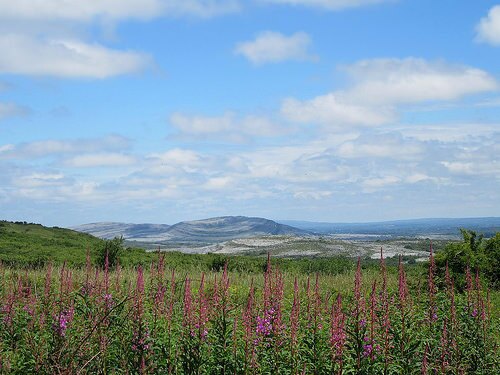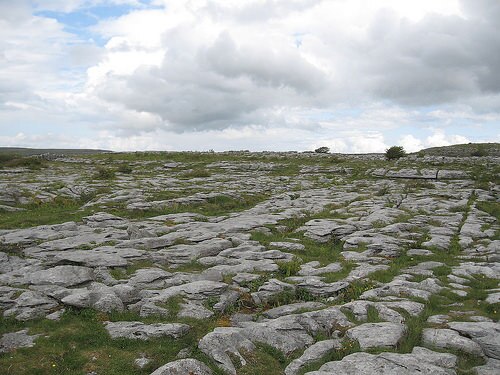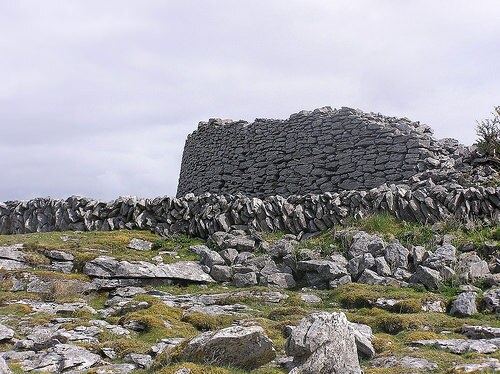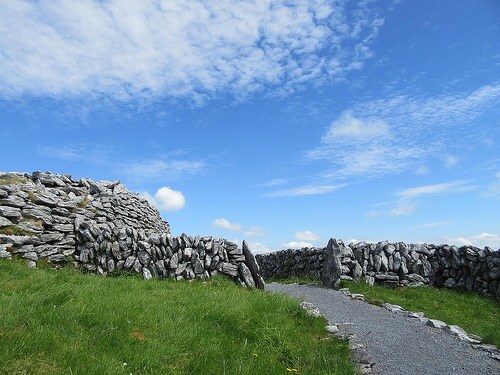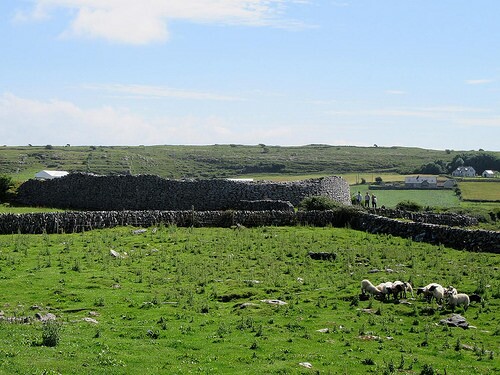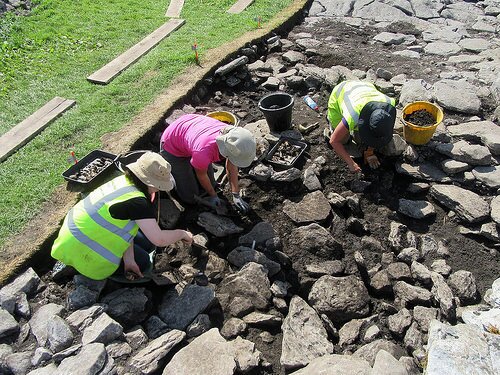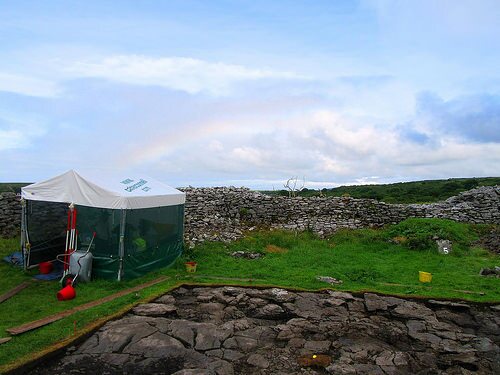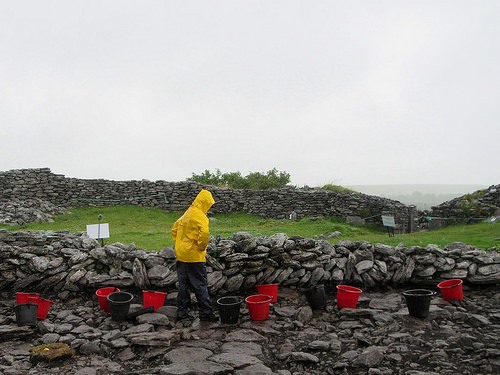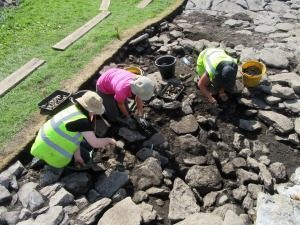
Everyone knows it as the Burren. Lush green vegetation pockmarks its otherwise ruggedly beautiful yet curiously desolate grey limestone pavement — a pavement initially laid down as sediments of a tropical sea more than 350 million years ago, but much more recently sculpted by Ice Age glaciation ‘only’ 10,000 years ago. Characterized by criss-crossing cracks known as “grikes”, which also leave isolated rocks called “clints”, it is a unique panorama that marks a distinguishing feature of Ireland’s western geography. Edmund Ludlow, a 17th century English parliamentarian, once described the Burren as “a country where there is not enough water to drown a man, wood enough to hang one, nor earth enough to bury him…… and yet their cattle are very fat; for the grass growing in turfs of earth, of two or three foot square, that lie between the rocks, which are of limestone, is very sweet and nourishing.” And to this day, a healthy and thriving population of cattle and sheep remain prominent players on the Burren landscape.
___________________________________
Above and below: The Burren countryside. Top image courtesy Kate Leonard. Bottom image HEireann, Wikimedia Commons
________________________________________________
Needless to say, the Burren draws tourists.
And archaeologists.
This is because the Burren is rich with historical and archaeological sites. Archaeologists and historians have documented more than 90 megalithic tombs and approximately 500 ringforts – such as Cahercommaun, a cashel which sits on the edge of an inland cliff, and the astonishingly well-preserved Caherconnell Cashel (Stone Fort). It is a tapestry of human presence extending back before the written word.
At this writing, a team of archaeologists and students are busy at work, methodically digging at the Caherconnell Cashel site. They can be seen crouched on their knees atop grey stone and soil, scraping and slicing carefully down with their trowels to expose stone floor surfaces, wall structures, and other features that testify to a long Medieval period occupation.
“Caherconnell Cashel is a possible royal settlement occupied from 10th century to the 15th/16th century AD,” says Kate Leonard*, a supervising archaeologist who worked at the site during the summer of 2016. “The cashel is a drystone (no mortar) enclosure: a 4m-high limestone wall enclosing a circular area that contained dwellings, the enclosure having an east-facing entrance. Already the excavations in the interior of the cashel have revealed evidence for a series of occupation and building phases that indicate a long period of use.”
The 1200+ Medieval artifacts thus far uncovered include clothes-fastening pins of bone, iron and bronze; iron shears; knives and other tools; whetstones and quernstones; glass and amber beads; a silver finger ring; iron and bronze buckles; a bronze tuning peg from a harp; iron arrowheads; and intricately carved bone hair combs.
And plenty of animal remains.
“The underlying limestone bedrock of the region creates an alkaline condition (non-acidic) that preserves bone wonderfully,” continues Leonard. “As a result, there is a large animal bone assemblage from the site that tells us the cashel’s occupants throughout the Medieval period had a varied diet including pig, sheep/goat and cow milk products and meat, fish, shellfish, domestic poultry and their eggs. The meat in their diet was supplemented with gathered herbs, fruits and nuts, like the ever present hazelnut, and cereal grains like barley, oats, rye and wheat ground by hand into flour and/or meal using heavy stone rotary querns.”
____________________________________
Above: A view of the Caherconnell Cashel (stone fort). Dabhoireann, Wikimedia Commons. Below, views of the Caherconnell Cashel by Kate Leonard.
_____________________________________________________
The recent excavations at Caherconnell began in 2007 with a trial excavation. Results were promising, so in 2010 archaeology field school excavations began under the direction of Dr. Michelle Comber. Those excavations have revealed structures and artifacts which include stone walls, animal bone and finely worked metal objects that all together are beginning to tell the story of the Gaelic people who lived and worked here during Medieval times. “It is a story not fully told through written history,” says Leonard. The finds are helping to paint a fuller picture of the day-to-day lifestyle of these people, who lived in a time when, says Leonard, the written narrative has been dominated by the history, politics, archaeology, and documented architecture of the Anglo-Normans who invaded Ireland beginning in the 12th century AD.
Because the limestone bedrock is close to the topsoil, the team has been able to uncover a large area in a relatively short period of time, exposing much of the interior features of the stone fort, affording a rapidly developing picture of its foundations and layout, including new structures. “I was digging in an area of the site where the foundations of a round structure, and associated internal features, were revealed that likely dates to the earliest occupation of the cashel – the 10th century AD,” says Leonard. Site director Comber suggests that this structure was ancillary to the centrally located dwelling house within the stone circle of the cashel, and that it may have also functioned later as a place for storage and/or refuse disposal. “The workshop idea relates to the discovery of some metalworking slag inside the structure, and a furnace and metalworking hearth on the north side of the structure,” says Comber. “A stone-lined hearth inside the structure contained more non-industrial charcoal, charred hazelnut shells, and regular small fragments of burned animal bone.” Additionally uncovered features are raising new questions. “Secondary activity relates to the quarrying of a large pit within the structure – with a concentration of charcoal and carbonized material in its lower fill, and frequent large animal bones in the upper fill,” adds Comber. “There is the possibility of a flue leading into this pit, which would suggest its primary use as a cereal-drying kiln.” Comber believes further investigation may shed more light on this.
______________________________________
Above: Field school team members excavating at the site of the Caherconnell Cashel. Courtesy Kate Leonard
___________________________________________________
Above: Because the underlying limestone bedrock is relatively close to the topsoil, field school members can make significant progress uncovering new features within the cashel. Courtesy Kate Leonard
___________________________________________________
Archaeologist Kate Leonard on site on a wet day at the Caherconnell Cashel. Courtesy Kate Leonard
______________________________________
Most significantly, archaeologists hope that the results of the excavation will help unfold a new chapter in the ongoing search for the unwritten history of the Gaelic people who inhabited Ireland. “It is very important that the story of the native population is put back into the narrative of Medieval Ireland,” says Leonard. And given that so many of today’s population can trace their roots to Gaelic ancestry, this is no small statement.
___________________________________________________
*Leonard’s time at Caherconnell was brief, as she is engaged in a global year-long journey to work at twelve different archaeological sites in 12 separate countries. She calls her project Global Archaeology: A Year of Digs. Caherconnell now makes the 7th stop on her global trek.
Popular Archaeology will be following and reporting on Leonard’s worldwide experiences periodically throughout 2016 as she hops from one location to another during her global journey. To continue the work, however, Leonard will need financial support from donors. Readers interested in reading about and supporting her self-directed Global Archaeology crowdfunded project can learn more at gofundme.com/globalarchaeology.
See more about Leonard’s experience at Caherconnell here, and you may also read more about the site and the project at its website.
__________________________________

______________________________________________
Travel and learn with Far Horizons.
____________________________________________
This richly illustrated issue includes the following stories: Recent findings shedding new light on the whereabouts of the remains of Philip of Macedon, father of Alexander the Great; how an archaeologist-sculptor is bringing bones of the dead back to life; archaeologists uncovering town life at the dawn of civilization; an exclusive interview with internationally acclaimed archaeologist James M. Adovasio about what makes the Meadowcroft Rockshelter prominent in the ongoing search for the first Americans; what archaeologists are finding at the site of the ancient city of Gath, the home town of the biblical Philistine giant, Goliath; and how scientists are redrawing the picture of human evolution in Europe. Find it on Amazon.com.

